Got to run around with friends and kids this weekend, and played with a certain Mr. F's new Nikon (it's dreamy!). And if you get the Mr. F reference, you are also excited about May 26. Anyway, I'm feeling the inspiration for a post.
Question
How do you take good photos of kids?
--Stock answer: blah blah blah blah blah
--My answer: Psychology. Tactics. Manipulation.
Let's take a step back - what makes a good photo?
(1) Technically solid (focus, exposure, whatnot)
(2) Follows principles (framing, rule of thirds, etc)
(3) Artsy stuff (tells a story, interesting subject, visually neat)
After hummingbirds, meteorites and dark matter, kids have to be the most difficult subject to meet all three criteria:
--They are always moving...away from you
--They are really short and unpredictable
--They really don't care about the aesthetics of your photography
Not following me? Here are a few illustrations from a
fabulous (crappy) blog. For context, Leah is somewhere between blurry stage and performer stage, and fortunately her signature smile is nothing like the one my brother Luke wore from ages 3-14.
On the flip side, if what you want is the product of kneeling down and following the action as best you can, congratulations - the camera's memory card overfloweth with such gifts:
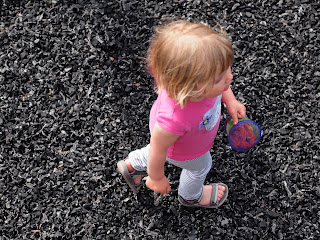 |
| I've got more of these than Favre has interceptions |
#1 The Snare
Say you are in the yard with your little darling. The sun is nice, her face is relatively clean, she's wearing something you are willing to show to others. It's a photo op. If you just pull out the camera and start shooting, odds are you'll get a bunch of photos that are a whole bunch of nothing special.
Shoot wide open? Good luck focusing. Take a deeper Dof? Now there's blur. Use a high ISO? You've gotta crop so much that the grain kills the shot. Want to see her face? Too bad, she's not looking at you. Whatcha gonna do?
Lots.
You know your child. You know what she'll respond to. You know what bait to put in the snare.
--Pick a good place for a photo, assuming your kid was standing there, then get your camera set.
--Maybe throw a stick there and see if she'll play fetch
--Maybe have a race...but instead of racing you just wait for her to run through a the spot (she just wants to win, anyway)
--Have her go down a slide and just wait at the bottom. Each time you can get a few shots.
You'll get something like this. It doesn't even matter if she's playing the same game as you, so long as she hit her marks:
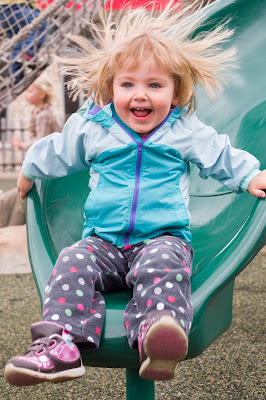 |
| This was her 10th time down that slide |
 |
| Dad: You go down first, I'm scared. Daughter:.So, Dad, you coming down yet? |
|
Interestingly, these are two different parks on two different days. Would you say that she has a few favorite outfits?
#2 Go Hide
Another technique - tell her to hide behind a tree from you. You have no intention of going to find her, but you know that she has no patience and will soon peek around to look if you are coming. Actually, it can be anything. A subject will frame herself very nicely by peeking around an object, and it's a flexible enough technique to use almost anywhere.
You can make this photo:
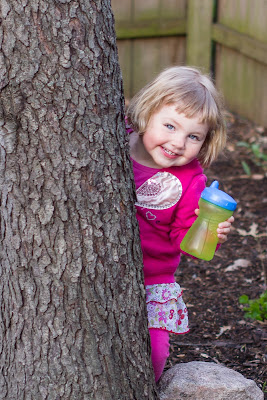 |
| I can hide for at least 5 seconds. |
#3 PBS is like GameGenie for Cameras
Indoor portraits? What do you think god invented PBS Kids programming for? Education? I can take 500 photos of her in the afternoon sun, as many angles as I like, and I can pretty much do anything so long as the Curious George is still on.
You can make images at F1.8, without cropping, at a low ISO!
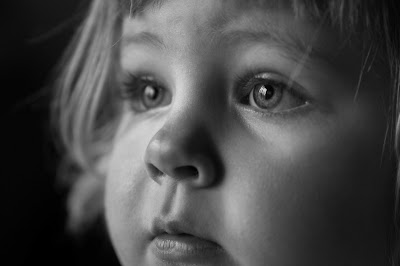 |
| ISO 200 45mm F1.8 1/60 sec |
#4 Passive Observer
This is the most elusive and most effective method - find a time when she's doing something that's got her engrossed...and is worth blogging about. Wait...that's not the goal? Whatever.
I try to keep the camera within a 5-sec sprint at all times, so when such an opportunity presents itself I have a fighting change to document the moment. In this case she had (a) agreed to have her hair made "fancy," and was (b) willingly brushing her teeth. The mirror made a fun frame for the shot.
This has never happened again.
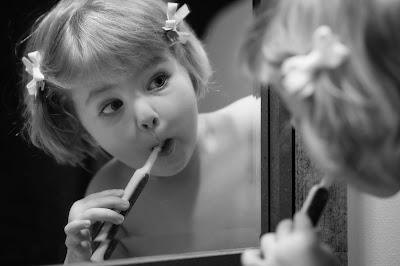 |
| Proof for the dentist |
Easy Mode
Here's a little sample from the simple days of yore (and an older post) -
photographing a sleeping baby. Super easy to compose, get the right
exposure, choose your depth of field.
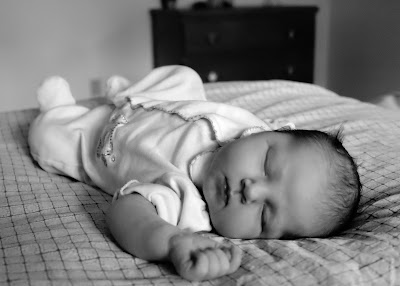 |
| Composing this was as challenging as stealing candy from her |
Of course, stress and sleep deprivation are questionable fuels for creativity. Want to know what it's like? Stay up all night doing something delicate and difficult that you have no idea how to do (e.g. disassemble/reassemble your DVD player), then as the sun rises take a stunning photo of your cat.






























